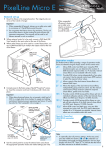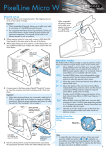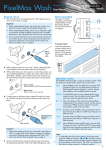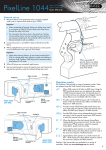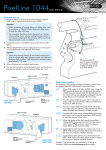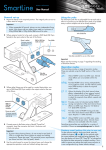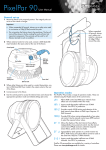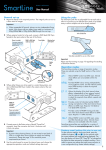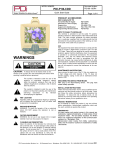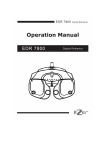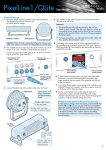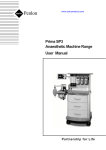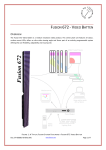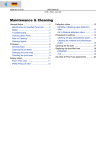Download User manual ver. 1.56
Transcript
PixelLine Micro W Version 1.56 firmware User Manual General set up 1 Mount the fixture in the required position. The integral yoke can act as a floor stand or hanger. When suspended off ground, always use a safety wire rated to a minimum of 11kg (25lbs) around the yoke Important • When suspended off ground, always use a safety wire rated to a minimum of 11kg (25lbs) around the yoke. • Do not position the fixture close to fog machines. The fog oil mist will be drawn in by the cooling fan and will short out important components. The warranty will be void for all fixtures returned in such a condition. 2 Where external control is to be used, connect a DMX lead (XLR 5-pin female) to the input socket at the rear of the fixture. 3 Where other fixtures are to be used in a control daisy-chain, connect a DMX lead (XLR 5-pin male) to the output socket at the rear of the fixture. DMX out (XLR 5pin female) socket Operation modes The PixelLine Micro Wash provides a range of operation modes. These are selected using the MODE section of the control menu: UP N W DO R TE EN U N ME ns om ructio e.c inst ng ting lra opera ixe proper p . r ww al fo w *R efe r to pro du ct ma 4 Connect power to the fixture using a Neutrik® PowerCon® connector. Insert the connector and twist it clockwise until it clicks into place. Important • When daisy-chaining fixtures, do not exceed a total load of 3kW in a single daisy chain (subject to supply and cabling restrictions). Maximum power requirement per fixture: 66 watts. See also the ‘Start up (peak)’ note on page 4. Power out socket (Neutrik® PowerCon® NAC3FCB connector required) UP N W ns om ructio e.c inst ng ting lra opera ixe proper p . r ww al fo w *R efe r to pro du ct Provides RGB(A) colour mixing independently of any external control. Use the internal control menu (MAN section) to select the required colour values. EF d Allows the control of the dual internal chase effects via external DMX input. EF M Allows the display of the dual internal chase effects, independently of any external control. Use the internal control menu (PROG section) to select the required chase effects, speeds and cross fades. 4+E Provides control of RGBA mixing and selection of the dual internal chase effects via DMX input. Requires 11 DMX channels. 16bt Allows RGB(A) control via DMX input, using two 8bit channels per colour. The RES option determines whether 6 or 8 channels are required. Internal chase effects are not available within this mode. Neutral ER T EN NU MANU Neutrik® PowerCon® (NAC3FCA) connector wiring DO ME Allows RGB(A) control via DMX input. Using the RES (resolution) option you can determine the number of DMX channels required: either 3 or 4 channels. Internal chase effects are not available within this mode. nu DMX in (XLR 5pin male) socket DMX ma Live N L nu Earth Fuse holder (on underside, see page 4 for details) Power in socket Neutrik® PowerCon® (NAC3FCA) connector 5 Use the control panel to access the internal menu and choose the appropriate operation mode and related settings (see over). Note • To optionally clear all previous settings: At the rear panel, press the middle two buttons ( and ) while the current address and mode are being displayed. The four digit display will show FACT then SET to indicate that the fixture has been returned to its default condition. Menu operation General notes Using the menu • Ensure that only one DMX • When not in the menu, the four digit display scrolls the device in the chain is set as master (e.g. the lighting desk). This fixture is usually set to slave mode. •This fixture is shipped with the DMX address set to 001. •The four digit display can be set to switch off when not in use. To restore, press . To alter this mode use: PERS > DISP. MENU ENTER DOWN to enter the menu. The four digit display will show ADDR. •Press and to move between menu options (or to change a •Use value within an option). UP to enter an option (or to fix a changed value within an •Press option and return to the previous option level). Note: If you do not press to fix a value, operation will revert to the previously set mode at the next power on. www.pixelrange.com to exit from a menu option (and eventually •Press exit the menu completely). *Refer to product manual for proper operating instructions Chase effects Channel layouts within operation modes This section describes each of the 31 internal chase effects that are selectable either via the control menu (prog > c1/c2 > EFEC) or using DMX values sent from an external source. To use the internal effects, set the mode option either to ef m (to control effects via the menu) or EF d / 4+E (to control effects externally via DMX). See page 4 for details about controlling effects on other fixtures via DMX without using a control desk. The table below shows how colour mixing, chase effects and master intensity controls are mapped to DMX channels for each mode. The dmx and16bt modes do not use chase effects. In all modes, the first channel of the fixture occurs at the DMX address selected using addr and successive channels for the fixture follow from there. DMX EFEC Chase effect description value value Channel 0-7 00 Off 8-15 01 Rainbow chase forward 1 Red+Amber Red 16-23 02 Rainbow chase reverse 2 Green Green Red+Amber (fine) Red (fine) 24-31 03 10/90 duty cycle strobe white 3 Blue Blue Green (course) Green (course) Blue 32-39 04 10/90 duty cycle strobe white 4 Master int.* Amber Green (fine) Green (fine) Amber 40-47 05 10/90 duty cycle strobe white 5 - Master int.* Blue (course) Blue (course) c1 Effect 48-55 06 50/50 duty cycle strobe white 6 - - Blue (fine) Blue (fine) c1 Speed 56-63 07 50/50 duty cycle strobe red 7 - - Master int.* 64-71 08 50/50 duty cycle strobe blue 8 - - - Amber (fine) c2 Effect 72-79 09 50/50 duty cycle strobe yellow c2 Speed 80-87 10 50/50 duty cycle strobe green 88-95 11 Pulse strobe white 96-103 12 Pulse strobe blue 104-111 13 Pulse strobe rainbow 112-119 14 Pulse strobe red/green/blue 120-127 15 Primary/secondary chase 128-135 16 Red/green/blue chase 136-143 17 Yellow/blue chase 144-151 18 Rainbow chase 152-159 19 Yellow/blue chase 160-167 20 Red/blue chase 168-175 21 Red/yellow chase 176-183 22 Red/green/blue chase 184-191 23 Green/purple chase 192-199 24 Red/green/blue chase 200-207 25 Static orange 208-215 26 Static yellow 216-223 27 Static light blue 224-231 28 Static purple 232-239 29 Static red 240-247 30 Static green 248-255 31 Static blue PixelLine Micro personalities are available for a variety of controllers. For details, go to: www.pixelrange.com current DMX address and mode. The display’s right hand decimal point (data dot) is used to indicate status (see below). Note: The PERS > RES option determines the number of channels to use in DMX and16bt modes (16bt uses twice the number of channels setup within RES). dmX dmX (RES=4CH) (RES=3CH) 16bt) 16bt (RES=3CH) (RES=4CH) Red+Amber (course) Red (course) 4+E Red Green Amber (course) c1 Xfade 9 - - - Master int.* 10 - - - - c2 Xfade 11 - - - - Master int. * Master intensity for dmx and16bt modes are available only when the pers > mint option is set to on. course = High channel for 16-bit, fine = Low channel for 16-bit Dimming options (PERS > DIMR) You have a choice of dimmer curve control options: Master/slave/data indication The right hand decimal point (data dot) of the display is used to indicate the master/slave settings and also the presence of a DMX input signal, as shown below: FINE is the standard setting and is fully compatible with the dimming curves of previous Pixel Range fixtures. TV uses dimming frequencies that will eradicate any visible flicker when viewed by video cameras and broadcast systems. TUNG Alters the dimming response to closely emulate the very smooth action of standard tungsten bulbs. The TUNG setting can be used with all operation modes. However, within the effects modes (EF M, 4+E and EF D), the TUNG setting will only be effective if the C1/C2 speed option is less than 25 and the C1/C2 XFADE option is less than 127. Data dot ON Master mode Data dot FLASHING Slave mode (DMX data input present) Data dot OFF Slave mode (no DMX data present) Notes: • Ensure that only one DMX device in the chain is set as master (e.g. the desk). • Use PERS > data to change between master & slave modes. • When set to master mode, the fixture will scroll MASTER in place of a DMX address (when not within the menu). • If the display has been set to auto off (disp > aoff), the data dot will remain active but at a lower brightness. Menu contents Shows the installed revision of the main fixture firmware. This is for information purposes only, no changes are possible within this option. Shows the installed revision of the software used to control the four digit display panel. This is for information purposes only, no changes are possible within this option. Selects the cross fade speed between the steps of the selected c1 chase effect. Selects the speed of the selected c1 chase effect. Selects the primary internal chase effect. See Chase effects for descriptions. Select mode > ef m to show the selected chase. Selects the master intensity level of chase effects c1 and c2. Selects the secondary internal chase effect. See Chase effects for descriptions. Select mode > ef m to show the selected chase. Selects the cross fade speed between the steps of the selected c2 chase effect. Selects the speed of the selected c2 chase effect. Sets the red intensity. Select mode > manu (manual) to show the result. Sets the green intensity. Select mode > manu (manual) to show the result. Sets the blue intensity. Select mode > manu (manual) to show the result. Sets the amber intensity. Select mode > manu (manual) to show the result. (Affects DMX &16bt modes only) Determines how colours are assigned to DMX channels. Options are 4CH and 3CH (red & amber combined). Determines whether this fixture will act as a master controlling others. When controlled by DMX input, this fixture must be set to slav. Affects DMX &16bt modes only. When set on this enables the master intensity channel for dmx &16bt modes. When set on, this option scrolls through the primary colours at power on to demonstrate correct operation. Sets the base DMX address from which the control channels will begin. Determines the intensity of the four digit control panel display. Values range from 0 (dimmest) to 15 (brightest). When set to Aoff, the control panel display will blank out shortly after the menu is exited. The master/slave/DMX signal indication will remain active. Allows you to choose dimming curve & response rate. FINE is compatible with previous Pixel range fixtures. TV prevents flicker on camera. TUNG produces very smooth responses. 8bit RGB(A) control using the number of DMX channels determined by PERS > RES. PERS > mint set to on provides a master intensity. No chase effects are selectable. Displays the resulting RGB levels that are set via the man section of the internal menu. When set as master, these levels are also output via DMX for the control of other fixtures. Ch1 to 3: C1 Effect, Speed & Xfade, Ch4 to 6: C2 Effect, Speed & Xfade, Ch7: Master intensity. Displays the chase effect(s) determined within the prog section. When set as master, these levels are also output via DMX for the control of other fixtures. DMX Ch1 to 4: RGBA, Ch5 to 7: c1 Effect, Speed & Xfade, Ch8 to 10: c2 Effect, Speed & Xfade, Ch11: Master intensity. 16bit RGB(A) control using 2x the number of DMX channels determined by PERS > RES. PERS > mint set to on provides a master intensity. No chase effects are selectable. Using master mode to drive other units This unit can control any number of other Pixel Range fixtures via DMX links, without the need for a control desk. Specifications Dimensions 1 Set this unit as master (PERS > DATA > MAST) and ensure all others are set to slave (PERS > DATA > SLAV). Connect all fixtures via DMX daisy-chain. 16 7m (6 1/ m 2” ) m 3m 20 ”) 8 ( 2 Set slaves to Mode > DMX. Set the master to either: •Mode > EF m and use PROG to choose effects, or •Mode > MANU and use MAN to choose colour mix. mm 863 ”) /8 (3 3 Use ADDR > DMX to set slave addresses (the master unit’s DMX address is ignored): •Effects: 18 cells are output in groups of 3 DMX channels to give RGB values per cell (54 channels in total). Set the address of each slave fixture according to which of the 18 cells you want them to appear within, or to begin with (for multi-cell fixtures): (A001 for cell 1, A004 for cell 2, ... A052 for cell 18). Set RGBA slave fixtures to 3 channel mode (using PERS > RES > 3ch). Note: The dimensions shown above relate to the main fixture body. The yoke knob extends 10mm (3/8”) beyond the stated width of the fixture. •Colour mix: Set slaves to any addresses on 4 channel boundaries, e.g. A001, A005, A009, ... A048. 150mm (5 7/8 ”) Troubleshooting Fixture remains at blackout when illumination expected 110mm (4 1/3 ") • If the display panel is not showing any indication, even after a button press, check the input power and fuse. • If live DMX is connected, the right hand decimal point on the display should flash - if not, check the DMX cable and the desk output. Weight • Check that the selected MODE matches the desk personality being used. Power • The master intensity channel for the current mode may be set at zero. For DMX or 16bt modes, check the setting of PERS > MINT. Fixture and yoke: 2.1Kg (4.6lbs) Input voltage: 90 to 264V AC, 47 to 63Hz autosensing Earth leakage 0.12mA Connectors: Neutrik® PowerCon® (see first page for details) • Ensure that only one DMX device is set as master. Power requirements: @ 230V/50Hz @ 115V/60Hz • Standalone chase effects: Effects programmed using PROG > C1 and C2 but the fixture is not in MODE > EF M mode. Check also that PROG > LEVL is not set at zero. Standby 2 watts 2 watts Maximum (const.) 66 watts 66 watts Start up (peak*) <40 amps <20 amps • Standalone RGB mixing: Colour values set within MAN section but the fixture is not in MODE > MANU mode. * The peak value occurs only at first power up and lasts only for a period measured in microseconds. Adjustments may need to be made to supply circuit breakers when multiple fixtures are daisy-chained, causing them all to draw the peak simultaneously. Fuse access The single fuse is located on the underside panel of the fixture. To remove the fuse Using a flatblade screwdriver, push down the fuse cap and then twist it anti-clockwise until it disengages from the holder. Approvals Miscellaneous Fuse type: 20mm 2A (T2AH) anti-surge, ceramic body Enclosure rating: IP20 (not protected against moisture ingress) Control input: USITT DMX512 (input connector pin out below) PIN 1 PIN 5 Ground Not used PIN 2 Data – Documentation by Corporate Text & Design (www.ctxd.com) Data + Release 1.56c UK +44 (0)1905 363600 [email protected] PIN 4 PIN 3 www.pixelrange.com USA +1 865 675 3955 [email protected] Not used




